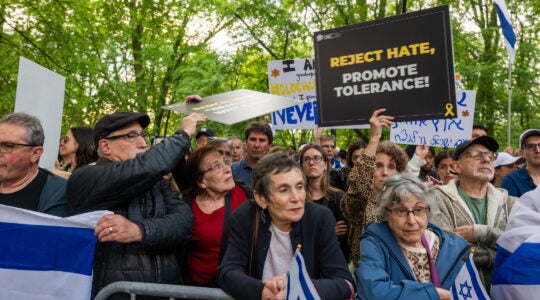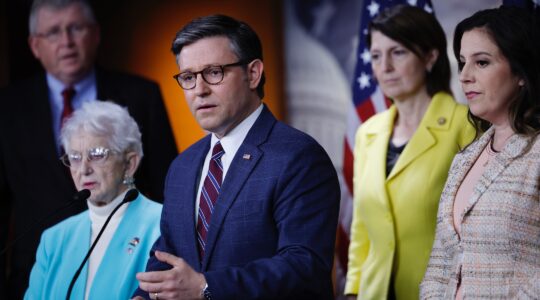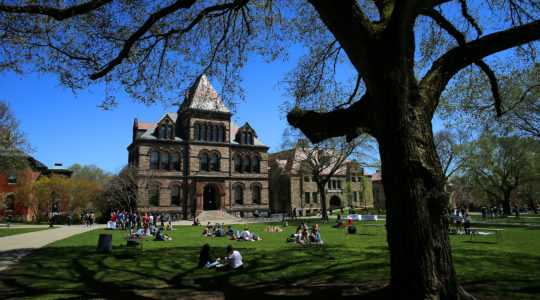NEW YORK (JTA) – With the annual General Assembly of the United Jewish Communities upon us, I have been asked to reflect on the challenge of engaging younger Jewish philanthropists in communal life. As a member of the next generation, I have wrestled with this question for more than a decade.
Approximately five years ago at the Andrea and Charles Bronfman Philanthropies, we created a division called 21/64 (www.2164.net) to focus on this very challenge.
“Engaging the next generation” used to signify the transference of leadership, like passing a baton from one generation to the next. Today, with the average life span increasing from 47 years old in 1900 to 78 years old in 2000, there are now four generations above the age of 21 in American society and four generations of adults who want to be engaged in Jewish life. Therefore, “engaging the next generation” actually means engaging multiple generations at once.
In the Jewish community, our institutions are often led by Traditionalists – those born between 1925 and 1945 – whose worldviews were imprinted with World War II, the Depression and the Holocaust. In giving back, they have built many of the institutions that are pillars of our communities.
[photo sharna align=right]
Baby Boomers, born between 1945 and 1964, outnumber Traditionalists and now represent the majority of our communal leadership. Their generational personalities were formed by the founding of the State of Israel; television brought the secular world into their Jewish homes.
Post-World War II economic opportunities led some to the suburbs, where they built synagogues and JCCs while others contributed to the social movements of the ’60s. With these distinct experiences come divergent lenses into Jewish life.
Add to that picture the different life experiences and styles of philanthropy of Generation X, born between 1965 and 1980, and Generation Y, born between 1981 and 1999. No wonder we are struggling to understand and accommodate additional generations, making our communications and planning even more complex.
Through 21/64, I travel to different communities in North America consulting with families, foundations and federations about multigenerational philanthropy. My experiences across the United States and Canada – and affirmed by research – tell me my peers are self-confident about their Jewish identity, yet remain hungry for ways to connect.
I have started to comprehend that the question isn’t whether the next generation is prepared for its communal responsibilities. The question is whether the community is prepared for the next generation.
Some communities are just now realizing it is time to add more seats to their boards and allocation tables for members of Generation X. Those more forward-thinking communities that already have begun to engage the next generation are realizing the very act of engagement actually changes the shape of those tables.
The post-Baby Boomer generations in America have grown up with access to opportunities across race, religion, class, sexual orientation and even global boundaries that previous generations did not have. Technology has become more than TV in the living room but a way in which community is formed, connections made and communications conveyed.
The experiences these 20- and 30-somethings bring, the vocabulary and skills they draw on, the diverse social circles they move in, the questions they pose, all require a shift in the way our federations operate. Are we willing to adapt how we operate for the sake of who we want to engage?
If we endeavor to engage them on their terms and not just change the window dressing on what already exists, we will be planting the seeds of long-term relationships and our own Jewish future.
For example, this year I worked with a community that has made the engagement of 20- and 30-somethings a priority. However, when I asked what “engagement” meant to members of the community, I heard four different answers.
To a Traditionalist, engagement meant creating an agency for young adults. To a Baby Boomer, engagement meant creating outreach activities for 20-somethings.
When I asked the Gen-Xers what they hoped engagement meant, they envisioned seats at an allocations table. For a Gen-Yer, engagement signified a meaningful experience of Jewish life having nothing to do with allocating dollars or attending social events.
Eventually this community committed to involving Gen-Xers and Gen-Yers in structuring allocation decisions that affected themselves and their peers. But more important, I would ask us all to consider how members of Gen X and Gen Y can help the whole federation system? In the 21st century, wouldn’t we want experts in 21st century management, technology and communications – those who grew up with it – to help lead?
This idea was reinforced for me recently at the Family Firm Institute annual conference, where I heard a lecture on adaptability in family firms. The session description read “long-term survival and success and continuity is fundamental to their purpose.” I couldn’t help but compare this take on multigenerational family businesses to Judaism and the Jewish people’s attempt at long-term survival.
John Ward, co-director of the Center for Family Enterprise at Northwestern University, found that those family firms that could balance the family’s traditional business with the innovative ideas of the next generation were the most adaptable and therefore the most likely to continue down the generations.
Ward emphasized that those families who seek their adult children’s understanding of today’s markets have a better chance at long-term survival than those who continue to do just what they have been doing. In fact, it is their ability to adapt, to hold the paradox between traditional practice and innovation, where the real creativity takes place and continuity is achieved.
Continuity is not merely repeating what we have been doing with Traditionalists and Baby Boomers because that is who is leading now. If we can take the long view, reflect on our centuries of Jewish life, and from there hold the paradox between Jewish tradition and next generation innovation, we will be focusing on the right goal. If we can “go to the balcony,” as author William Ury offers, and see from our historical perspective that we are talking about the continuity of a people and not of an organizational model, the better prepared we will be for our community’s long-term survival.
In the Jewish world, I have witnessed this approach among a group of 20- and 30-somethings who envisioned Slingshot and The Slingshot Fund (www.slingshotfund.org). The founders, committed to Jewish tradition and their family legacies of philanthropy, seek to highlight and support ways in which the tradition is resonating with the next generation.
With the help of 25 Jewish funding professionals across the United States, 50 innovative and effective Jewish organizations and projects are featured annually in Slingshot: A Resource Guide to Jewish Innovation. Then the 50 organizations are invited to apply to the Slingshot Fund for resources to build their capacity for engaging the next generations. In its inaugural year, nearly $400,000 was raised and allocated by these next generation funders.
The real lesson in this example is how it was set up. We gave the next generation the proverbial keys to the car and in the end, they have taken better care of it than we could have ever imagined.
I have never experienced a more thoughtful and meticulous process where funders are trying to build a fund and a grantmaking process that reflects their Jewish and generational values. They are asking applicants what they need to do their work, investing in operating support, providing value beyond the grant money through their networks and different skill sets. And they are inviting people of all ages and income levels to get involved by opening up charitable giving on their Web site.
In being flexible about how these next generation funders became involved, the community succeeded in engaging the next generation, channeling philanthropic dollars into Jewish life and building relationships with people who hold our communal future in their hands.
Today, 20- and 30-something Jews are leading an array of organizations from nonprofits to hedge funds. As responsible managers of those organizations, they have the skills to lead. I believe that if we place our trust in them, they will be responsible stewards of the Jewish future as well.
Adding members of Gen X and Y to our allocation tables is an important first step, but if we can also acknowledge that the “kids” are now “adults” who can bring expertise, resources and leadership to the community, we can be less focused on “engagement” and more assured of our future.
It is a rare opportunity in Jewish history to have the resources that we have as a community. Even more exceptional is our opportunity to allocate those philanthropic resources with four generations around our communal tables.
Although multigenerational philanthropy requires us to hold the tension between our traditions and the innovation of the next generations, it seems well worth it to achieve continuity. Are we up to the challenge?
Sharna Goldseker is the vice president of The Andrea and Charles Bronfman Philanthropies, and director of its 21/64 division. She can be reached at sharnagoldseker@acbp.net.
JTA has documented Jewish history in real-time for over a century. Keep our journalism strong by joining us in supporting independent, award-winning reporting.





